I’ve used AI summarizers for everything, from long articles and YouTube videos to meeting transcripts and PDFs.
Most tools just condense text. The best ones understand context, extract key insights, and adapt to different formats.
In this guide, I’ll share the best AI summarizer tools in 2025, including options like Lindy that go beyond summaries and actually help you act on what matters.
What Is an AI Summarizer Tool?
An AI summarizer tool is software that uses artificial intelligence to condense long content into a short, clear summary. It reads and understands the original text, then rewrites the key points in fewer words without losing the main message.
What it can summarize:
- PDFs and reports
- Articles and blog posts
- Long emails and documents
- Meeting transcripts or call notes
- YouTube videos (with transcripts)
Why it’s useful:
- Saves time by skipping long reads
- Helps you understand content faster
- Great for research, content curation, or productivity
The 10 Best AI Summarizer Tools (TL;DR)
- Lindy: Best AI summarizer for meetings, tasks, and everyday automation
- Quillbot: Best AI note summarizer for academic papers
- ChatGPT: Best AI summarizer tool for flexible custom summaries
- Notta: Best AI video summarization tool for YouTube and web content
- Scribbr: Best summarizer AI for citations and research-heavy documents
- Jasper: Best summarizing AI tool for marketing and branded content
- Paraphraser: Best AI tool for breaking down blogs and web articles
- Scholarcy: Best AI document summarizer for scientific content
- ClickUp: Best AI task summarizer built into project management
- Writesonic: Best AI summary generator for long-form content
1. Lindy: Best AI Summarizer for Meetings, Tasks, and Everyday Automation
What does it do? Lindy is an AI assistant that summarizes meetings, automates follow-ups, updates CRMs, and handles repetitive tasks, like having multiple agents working behind the scenes.
Who is it for? Teams, founders, consultants, and anyone tired of juggling tools, repeating manual tasks, or losing track of action items after calls.
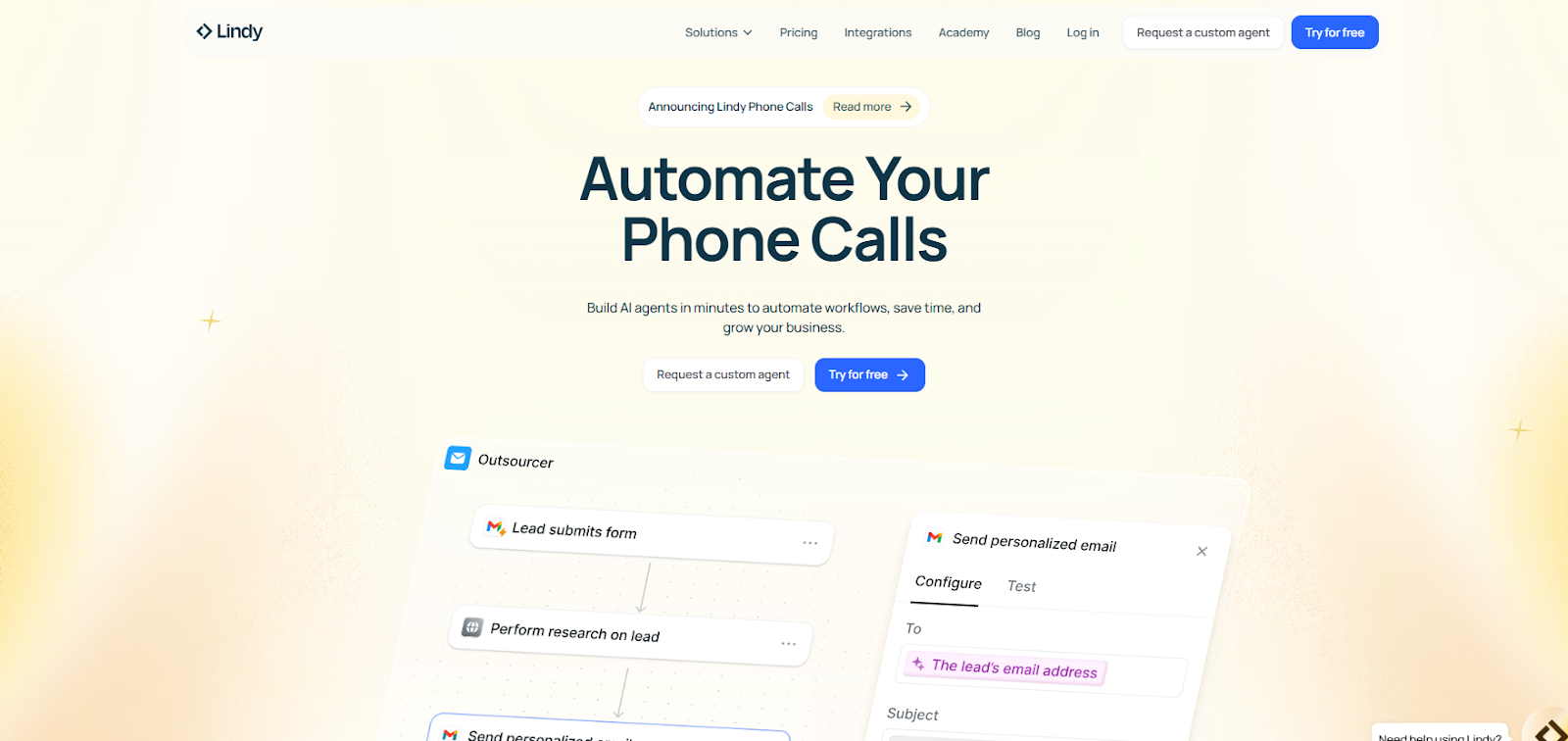
Most AI summarizers give you transcripts and walk away. Lindy goes a step further, it helps you do the things discussed in the meeting. It joins your Zoom or Meet calls, takes smart, speaker-labeled notes, highlights key decisions, and pulls out action items.
But here’s what sets it apart: Lindy can automatically follow up via email, update HubSpot or Salesforce, and drop tasks directly into Slack or Notion.
No coding required. Just use Lindy’s drag-and-drop workflow builder to connect your apps. You can build agents for support, sales, meetings, or internal ops, and they all work together to prevent missed follow-ups or duplicated effort.
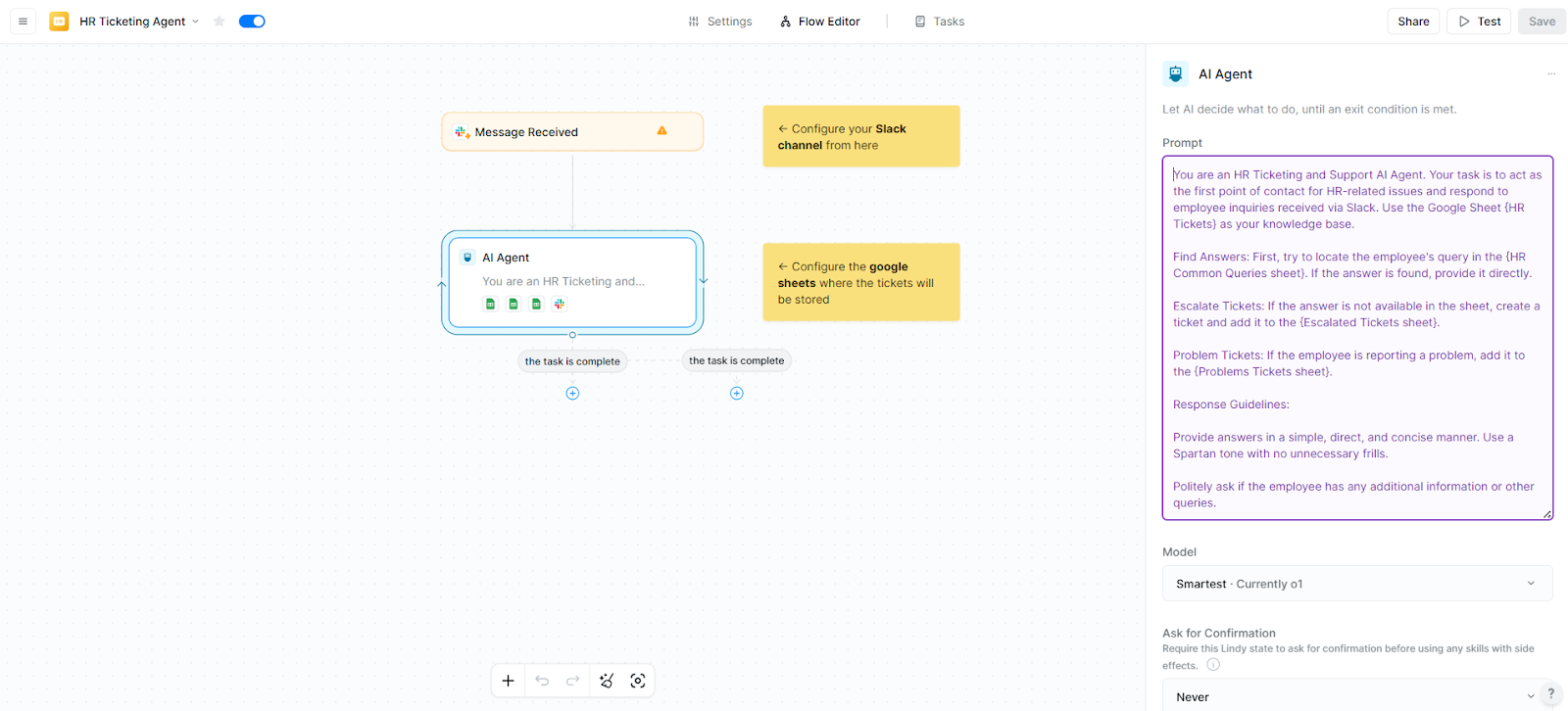
What’s even better: Lindy improves over time. It learns from your past conversations, documents, and internal tools, so you can ask context-aware questions like “What did Alex say about Q3?” and it’ll fetch relevant answers in seconds.
Using “Chat with PDF”, you can use different AI models and ask Lindy to help you summarize PDF files, ask questions, and even break down complex stuff for you. Similarly, you can explore other pre-built templates to automate your workflows.
It’s also privacy-conscious. Before sending anything, Lindy always checks with you. Nothing goes out unless you approve it.
Compared to tools like Otter (which only summarize) or ClickUp (which needs manual work), Lindy feels more like a coworker, taking things off your plate, not just tracking them.
Pros
- Lindy connects with thousands of tools
- 24/7 support with guided learning via Lindy Academy
- Knowledge base training makes each summary more tailored
- Works well even for solo professionals managing multiple roles
Cons
- Some integrations need manual fine-tuning to perform optimally
- Custom agents for complex workflows might need time to configure
Pricing
- Free Trial: Available, so you can try before you commit
- Starter Plan ($49.99/month): Includes core automation tools, good for individuals and small teams
- Growth/Enterprise Plan ($299.99/month): Designed for larger teams, includes advanced automation and scalability
{{templates}}
2. Quillbot: Best AI Note Summarizer Tool for Academic Papers
What does it do? Quillbot is an AI summarizing tool designed to help you rewrite, shorten, or polish existing content.
Who is it for? Students, researchers, bloggers, and professionals who often work with academic or content-heavy material.

Quillbot comes in handy when you’re working with dense material, think research papers, white papers, or essays, and just need to distill them into clean summaries. You paste your text, choose a summarization style (paragraph or bullet points), and get instant output that’s clear and usable.
It’s also a reliable rewriter. Whether you’re trimming a verbose section or refining tone, the tool offers different writing modes, like Shorten, Standard, and Formal, that help shape the content to your needs. It’s great for editing drafts, cleaning up citations, or cutting fluff without starting from scratch.
What I found especially helpful is that it doesn’t just summarize, it also assists with grammar, paraphrasing, and even citation formatting like APA and MLA.
The built-in grammar checker rivals Grammarly, and the AI humanizer makes robotic writing sound more natural. You also get extras like a citation generator, a basic translation tool, and a Chrome extension.
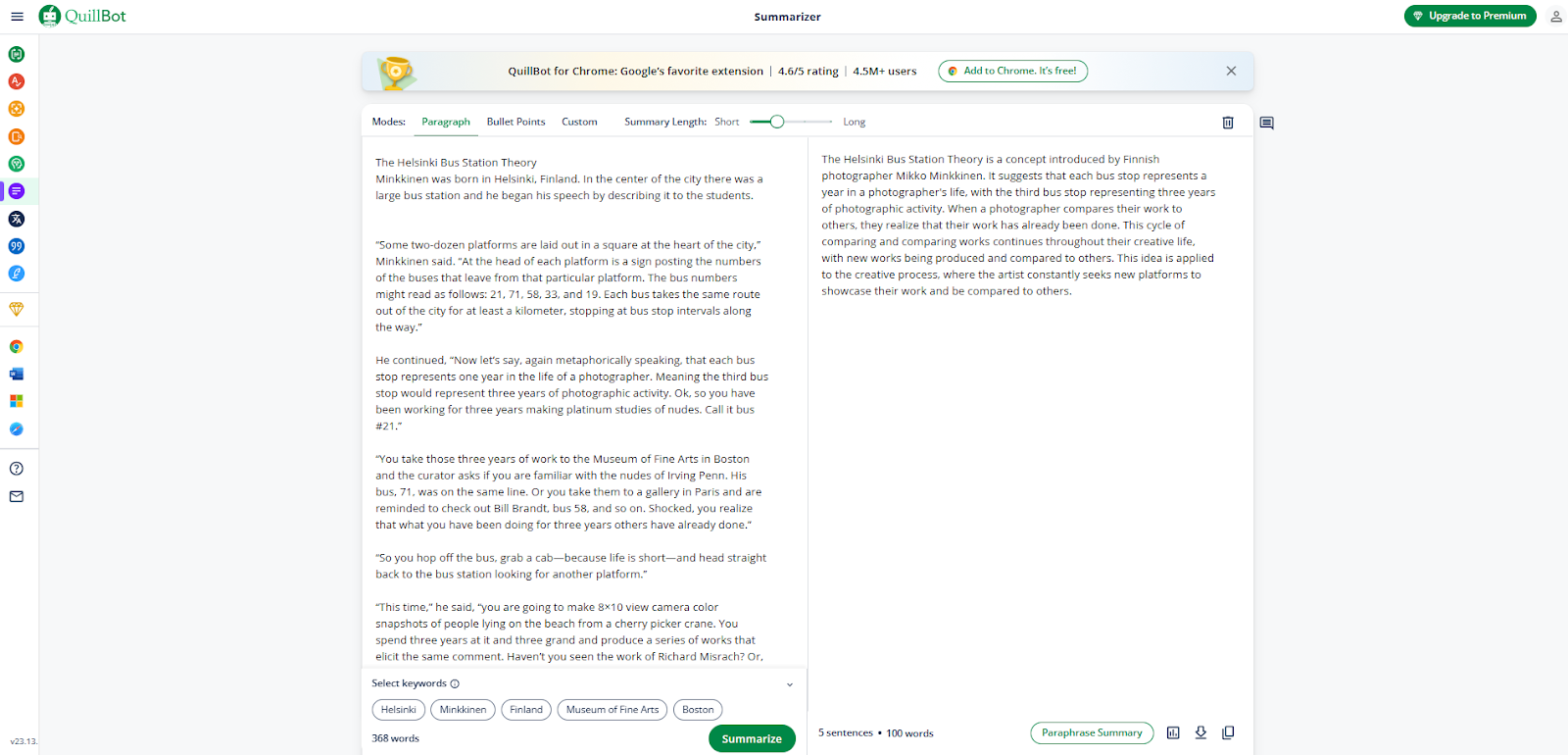
That said, the free plan has limits. Longer documents (like 6,000+ word essays) require the Premium plan, and plagiarism checks have usage caps.
Still, for anyone who deals with editing, rewriting, or academic summarization regularly, Quillbot is one of the most practical tools to keep in your tab stack.
Pros
- No login is required to use basic features
- Offers both bullet and paragraph summary outputs
- The side-by-side comparison feature is great for learning edits
Cons
- Summarizer quality drops for highly technical texts
- No batch upload support for multi-document workflows
Pricing
- Monthly: $9.95/month
- Quarterly: $6.65/month
- Annual: $4.17/month
3. ChatGPT: Best AI Summarizer for Flexible, Custom Summaries
What does it do? ChatGPT is a conversational AI tool that can summarize documents, meeting transcripts, call recordings, and even web content.
Who is it for? Writers, analysts, students, consultants, and anyone who wants flexible control over how summaries are written, structured, or formatted.

If you’re working with content that doesn’t follow a standard structure, like jumbled transcripts, scattered meeting notes, or multi-format documents, ChatGPT is one of the most versatile summarizers available.
You can ask it to rewrite a policy doc in plain English, convert a 10-page research paper into bullet points, or extract only the action items and decisions from a Zoom call. The real value here is control: you decide the length, tone, format, and even the structure of the summary.
With GPT-4o, that control goes further. You can now upload PDFs, drag in screenshots, paste raw text, or even speak your prompt aloud.
I’ve used it to build layered summaries, starting with a top-level overview, then diving into pros, cons, and next steps, across everything from company memos to long client threads. It handles follow-up instructions well, which means you can tweak and refine without starting over.
It’s especially good at interpreting vague or unstructured content. If the source material is messy, repetitive, or full of filler, ChatGPT usually knows what to cut and what to keep. You can also work in over 25 languages, making it a solid choice for global teams.
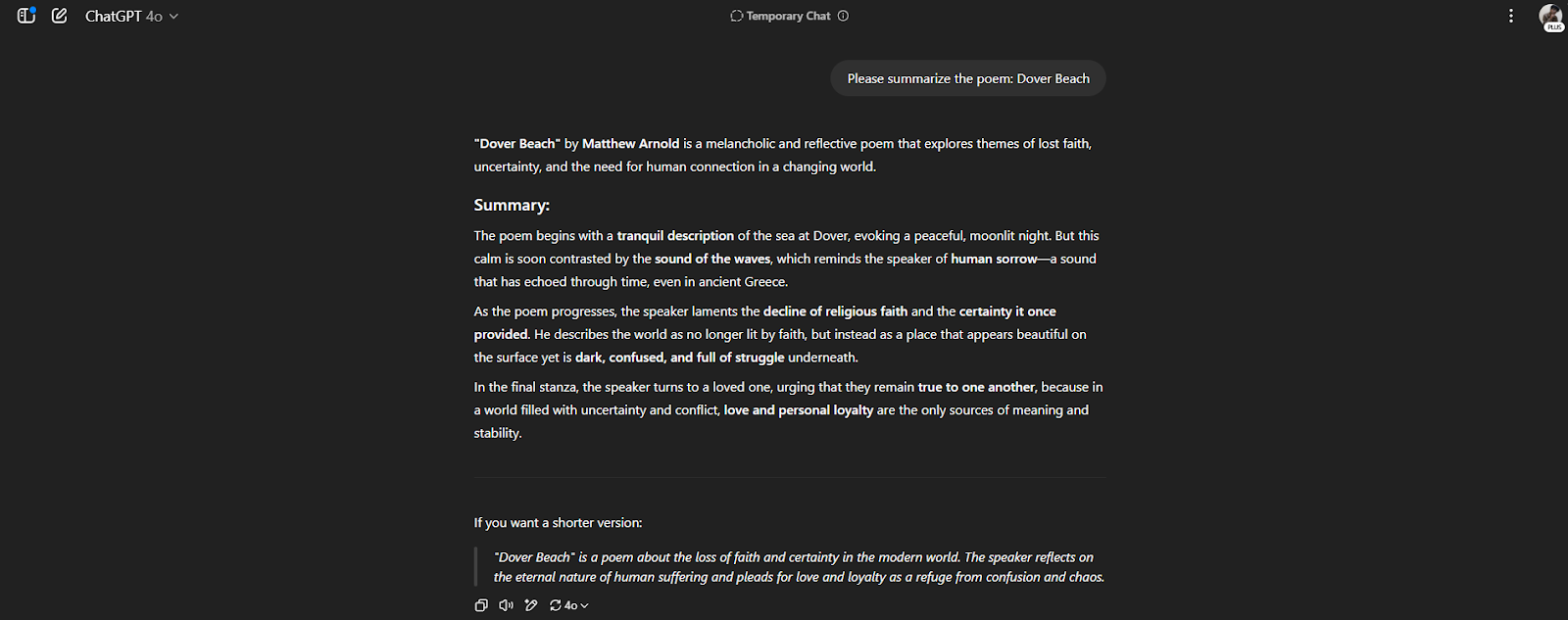
While it doesn’t generate summaries automatically, it rewards clarity. The sharper your prompt, the better your results, and that flexibility makes it hard to beat if you want full control.
Pros
- Prompt chaining allows complex, layered workflows
- File + voice input unlocks multi-modal summarization
- Works well for multilingual content and translation tasks
Cons
- Summaries can lack depth if the prompt isn’t specific
- May occasionally generate outdated or incorrect context
Pricing
- Free Plan: Access to GPT-4o with usage caps
- ChatGPT Plus ($20/month): GPT-4o with higher limits, faster speed, web browsing, file uploads, and image tools
- ChatGPT Team ($25–$30/user/month): Shared workspace, admin tools, higher usage limits
- ChatGPT Pro ($200/month): Access to OpenAI o1 and pro features like advanced voice, real-time reasoning, and premium memory capabilities
4. Notta: Best AI Summarization Tool for YouTube and Web Content
What does it do? Notta is an AI summarization tool built to convert spoken content into clean, structured summaries.
Who is it for? Teams, consultants, educators, and independent professionals who handle a lot of spoken content.
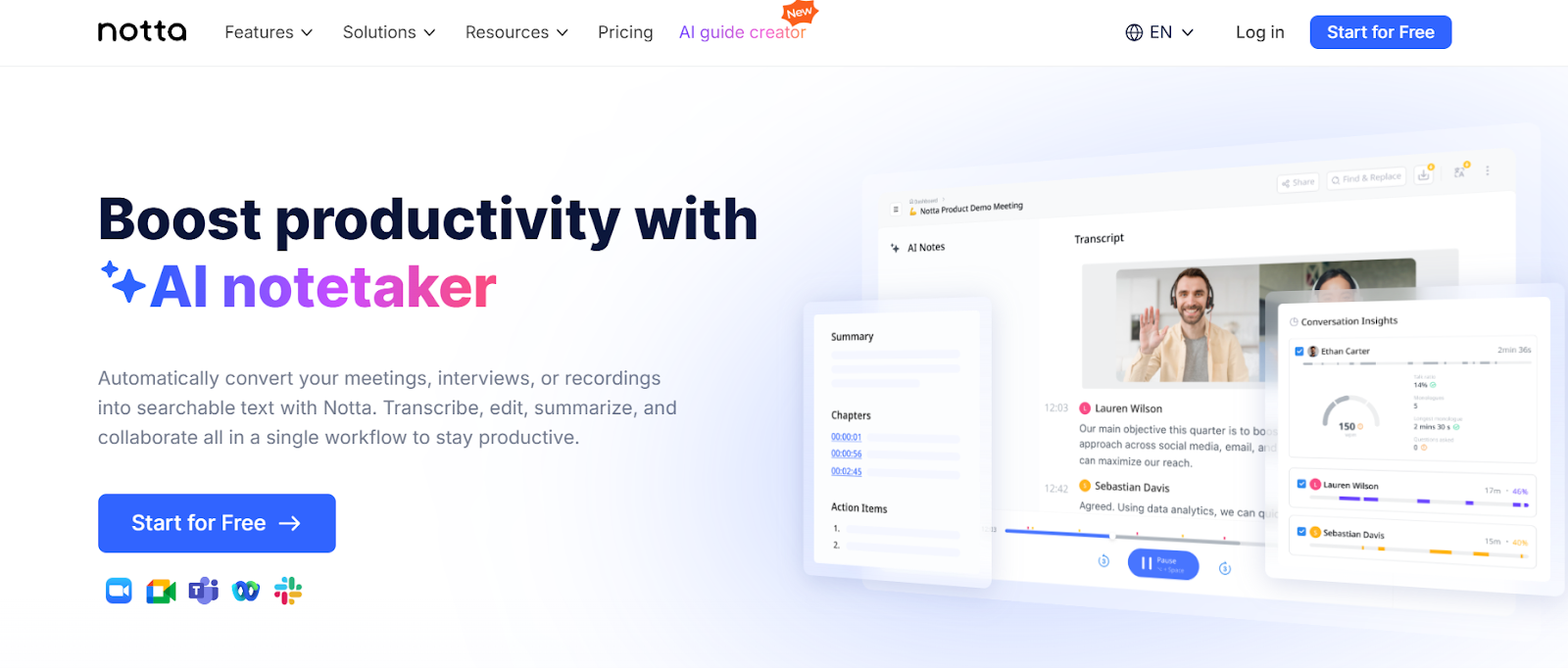
My workflow usually involves a lot of recorded meetings, client calls, and interviews, and Notta has fit right into that routine. I’ve uploaded Zoom recordings, transcribed YouTube videos, and even had the Notta bot join a few Google Meet sessions. In every case, the summaries came through quickly and were structured well enough to be used right away.
Getting started was easy. I just dropped in MP4 files, pasted YouTube links, or scheduled the Notta bot to join live calls. There was no complicated setup, and no extra tools were needed.
What makes Notta especially useful is how quickly it generates both a full transcript and a clean, structured summary.
The summaries highlight who said what, what decisions were made, and what action items follow next. You can also customize prompts, so if you’re only interested in capturing blockers or feature requests, you can train the tool to deliver just that, consistently and in your preferred format.
I’ve used it to push meeting notes into Notion and even shared public summary links with clients. It also supports tagging teammates, commenting, and assigning next steps, all from within the Notta dashboard. The built-in integrations with Slack, Google Calendar, and Zapier help it blend right into your stack.
Its speaker identification is solid, even in bilingual calls or with accented speech. With support for 58 languages, it's surprisingly accurate across global teams. So, if you're looking to break down spoken content without switching platforms, Notta fits right in.
Pros
- Onboarding takes less than 5 minutes
- Prompt templates improve accuracy over time
- Mobile app makes capturing notes on the go easier
Cons
- No offline transcription support
- Workspace UI can feel cluttered with large teams
Pricing
- Free Plan: 120 transcription minutes/month, 50 file uploads/month, 10 AI summaries/month
- Pro Plan ($8.17/month): 1800 transcription minutes/month, 100 file uploads/month
- Business Plan ($16.67/month): Unlimited transcription, 200 file uploads/month, 50 AI summaries/month
5. Scribbr: Best Summarizer AI for Citations and Research-Heavy Documents
What does it do? Scribbr is a free, browser-based AI summarizer tool built to condense academic content like papers, essays, and study notes into clear summaries.
Who is it for? Students, researchers, and educators need fast, reliable summaries of academic text.

Unlike most AI summarizing tools that focus on general content, Scribbr is built specifically for academic texts. It's fast, no-login, and works instantly in your browser. Whether you’re working through literature reviews, journal articles, or lecture notes, it pulls out core arguments without the fluff.
The interface is clean and straightforward. You paste up to 600 words, adjust the slider for summary length, and choose between bullet or paragraph format.
I usually keep it on bullet mode when prepping notes or reading responses. It’s ideal for focused, academic work where you don’t want distractions or overly stylized outputs.
What makes Scribbr unique is its source-highlighting feature, you can see exactly which parts of the input text contributed to the summary. This is especially helpful for cross-referencing citations or verifying interpretations, something other free tools rarely offer.
Although it only handles English and lacks integration with external apps or files, the privacy-first design makes it a go-to when working on public devices or tight deadlines.
Everything runs locally in the browser, with no tracking or ads. You can even export your summary as a TXT file without creating an account.
Pros
- Summary slider helps fine-tune depth quickly
- Perfect for last-minute reading prep or revision
- Works well on mobile browsers without any slowdown
Cons
- Lacks multi-language or file upload support
- No customization or workflow automation features
Pricing
- AI Summarizer: 100% free, no registration required
- Plagiarism Checker: Price per document; for up to 7,500 words ($19.95), 7,500–50,000 words ($29.95), and over 50,000 words ($39.95)
6. Jasper: Best AI Summarizing Tool for Marketing and Branded Content
What does it do? Jasper combines summarization with full-scale content generation.
Who is it for? Marketers, agencies, and creative teams who need AI support not just for summarizing but also for writing content.

When I used Jasper during a campaign planning workflow, I noticed it handled summarization differently from most general-purpose AI tools. It didn’t just shrink paragraphs but rewrote them to match our brand’s tone.
I could set the output style to be concise, casual, or formal, and adjust the length depending on where the content was going to be: a blog snippet, a subject line, or a landing page block.
A big reason this works so well is the Brand Voice Control Center. You can pre-define tone (e.g., witty, direct, empathetic), preferred terminology, formatting rules, and even how grammar should be handled. Once you set these, Jasper applies them across all outputs, including summaries, without you needing to constantly prompt it. That alone shaved hours off our usual editing process.
Beyond summarization, the Jasper Studio lets you turn a single content piece into multiple formats. I’ve taken blog posts and repurposed them into email campaigns, carousel slides, and newsletter blurbs in just a few clicks. You can also bounce between Jasper Chat and Studio to go from idea → draft → multi-platform content without breaking your flow.
It integrates easily into most setups, too. I synced it with HubSpot and Google Docs, and pushed outputs directly into Asana via Zapier. No copy-paste chaos, no switching tabs endlessly.
For marketing teams who care about brand voice, speed, and flexibility across content formats, Jasper isn’t just helpful, it’s efficient, consistent, and surprisingly creative.
Pros
- Supports collaborative editing in real time for team members
- Streamlines approval workflows with shareable content drafts
- Built-in AI prompts reduce the time spent thinking about structure
- Easy to align with regional language variations (e.g., US vs UK English)
Cons
- UI can feel overwhelming initially
- Some advanced features (like custom templates and API) are locked to enterprise tiers
Pricing
- Creator ($39/month): 1 user seat and access to basic AI content generation tools
- Pro ($59/month): 1 seat, add up to 5, 3 brand voices, 10 Knowledge assets, 3 Instant Campaigns
7. Paraphraser: Best AI Tool for Breaking Down Blogs and Web Articles
What does it do? Paraphraser is an AI tool that helps rewrite articles, condense long texts, and check for grammar and plagiarism in one place.
Who is it for? Students, teachers, bloggers, and everyday users who need a basic AI summarizer tool with additional rewriting and editing features.
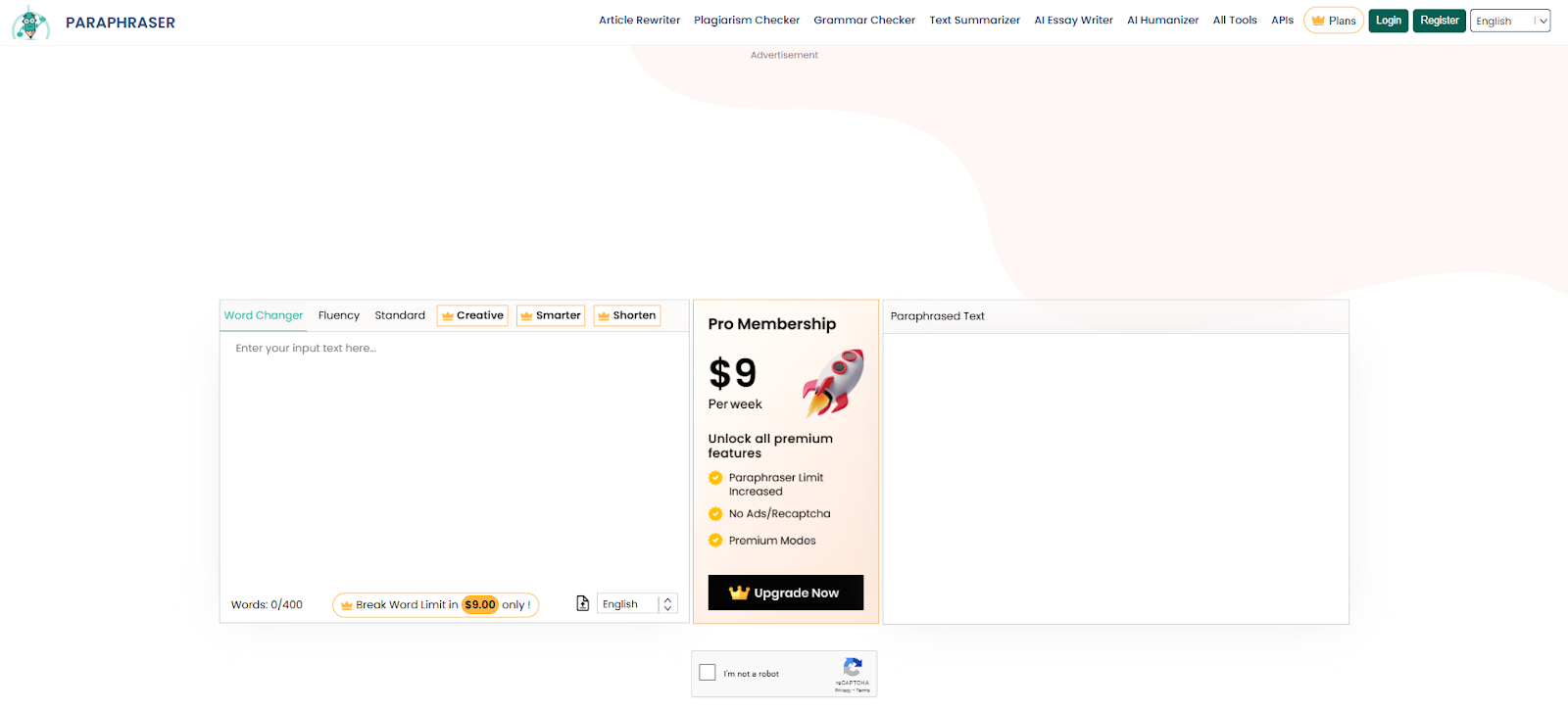
Paraphraser is built for speed and simplicity. If you're working with blog posts, web content, or essays and just want to shorten or reword them fast, this tool makes it easy. You paste your content, choose whether to paraphrase or summarize, and it gives you a cleaner, more concise version within seconds.
It’s not built for deeper analysis or layered meeting notes like what you’d do with a tool like Lindy and Notta, but for everyday written content, it gets the job done fast.
Paraphraser bundles everything, from grammar checking, plagiarism detection, and rewriting, to summarizing into one space. I don’t have to switch between apps to polish up a section, shorten it, and make sure it’s original. It’s all in one flow.
Another plus: Paraphraser supports over 20 languages. It’s not as deeply tuned for region-specific idioms, but it works well enough for bilingual writers and ESL students.
The UI is clean, mobile-friendly, and doesn’t overwhelm you with options. It’s especially handy when you're working on the go or cleaning up work outside your usual writing tools.
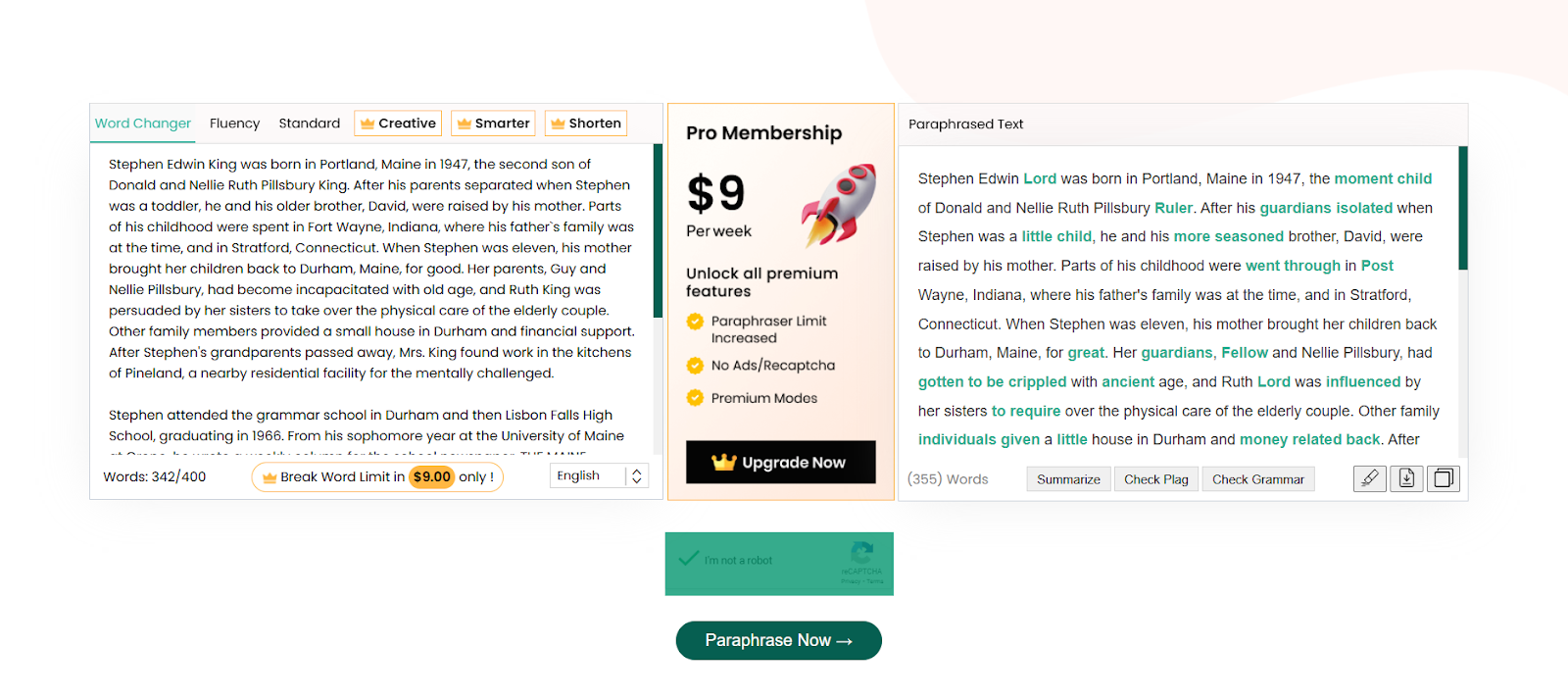
The free version handles basic summarization and rewriting, but if you need deeper features, like plagiarism results or higher word count limits, you’ll need to upgrade.
Pros
- Supports full-length inputs for long-form rewriting
- Simplifies dense content for non-native English readers
- Handles full-length documents without splitting manually
Cons
- Lacks tone customization or prompt flexibility
- Doesn’t connect to Google Docs, Notion, or other tools
Pricing
- Free Plan: Basic access to the AI summarization tool and rewriter
8. Scholarcy: Best AI Document Summarizer for Scientific Content
What does it do? Scholarcy is an AI-powered summarizer that breaks down dense research papers, book chapters and reports into summaries.
Who is it for? Students, researchers, and educators who regularly work with complex academic texts.

Scholarcy is more than a highlighter, it’s a full academic assistant. Instead of giving you a basic TL;DR, it splits long research papers into labeled sections like Abstract, Methods, Results, and Conclusion. I’ve used it to quickly assess multiple peer-reviewed studies while preparing literature reviews and it consistently delivered well-organized, source-backed summaries.
The real strength lies in its structure-aware approach. Scholarcy detects sample sizes, study methods, limitations, and key findings, even in messy or scanned PDFs. The Robo-Highlighter makes it easy to jump to relevant sections, like just the results or discussions, without needing to read the entire paper.
If you’re short on time, you can use the flashcard view for a high-level overview. For extensive work, toggle to detailed summaries, which you can export as Word, Markdown, PowerPoint, or Excel, useful for class prep or collaborative research. Accessibility features like text-to-speech and text resizing are really helpful for students with ADHD or dyslexia.
Scholarcy also pulls together bibliographies and reference lists automatically.
I’ve shared flashcards with teammates, used the browser extension for summarizing papers directly from URLs, and relied on accessibility features like text-to-speech during long reading blocks.
Compared to simpler tools like Scribbr, Scholarcy is tailored for academic rigor. Its breakdowns, export formats, and smart referencing make it feel more like a lightweight academic workflow hub than a standalone summarizer.
Pros
- Fast onboarding with no steep learning curve
- Works well with open-access academic repositories
- Text-to-speech improves accessibility for neurodivergent learners
Cons
- No real-time syncing with citation managers like Zotero
- Some summaries require manual double-checking for nuance
Pricing
- Free Summarizer: Limit of 10 summaries, export flashcards (one at a time)
- Scholarcy Plus ($45/year): Unlimited summaries, one-click bibliographies, cloud flashcard library
9. ClickUp: Best AI Task Summarizer Built into Project Management
What does it do? ClickUp’s AI summarizer condenses tasks, meeting notes, comments, documents, and even entire workspaces into short, actionable summaries.
Who is it for? Teams, project managers, and department leads who already use ClickUp for task management.

ClickUp’s summarizer isn’t just a bolt-on feature, it’s woven into how you manage tasks and communicate inside the platform. I’ve used it to distill cluttered project threads into quick updates, shorten multi-paragraph task briefs into digestible bullets, and generate workspace-level summaries that stay updated as new work is added.
The real strength is shown in the way it handles context. It doesn’t just pull from the latest comment but looks at the entire activity log, from file uploads and comments to field changes. That gives a full picture, which is great when I’m jumping into a project I haven’t followed closely or picking up where someone else left off.
It also picks up on action items and includes them in the summary, so the next steps are already clear. I’ve found this reduces the need for extra meetings or follow-ups as the summary already lays out what needs to be done.
You can also adjust the tone of the summary depending on who’s reading it. Internal team? Keep it casual. Client update? Make it formal. The control feels thoughtful, especially for cross-functional updates.
It's not trying to be a writing or content tool like Jasper, it’s strictly about clarity inside your project. One thing to note: there’s no built-in PDF or doc summarization, so if you want to summarize an external file, you’ll need to paste it in manually. And occasionally, the summaries can sound robotic or overly templated, especially with repetitive task formats.
Pros
- Fits naturally into agile and sprint workflows
- Great for onboarding new teammates mid-project
- Tone control helps tailor updates for different audiences
Cons
- Repetitive summary tone across similar tasks
- Full AI features are only available on paid plans
Pricing
- Free Forever: 100MB Storage, Unlimited Tasks, Two-Factor Authentication, 24/7 Support
- Unlimited ($7/user/month): Unlimited Storage, Unlimited Integrations, Unlimited Dashboards, AI Compatible
- Business ($12/user/plan): Google SSO, Unlimited Teams, Custom Exporting, Timesheets, Advanced Automation
10. Writesonic: Best AI Summary Generator for Long-Form Content
What does it do? Writesonic is a fast, AI-powered platform for generating summaries, long-form articles, product descriptions, chatbot responses, and more.
Who is it for? Marketers, content teams, and agencies need large volumes of accurate, SEO-friendly content.
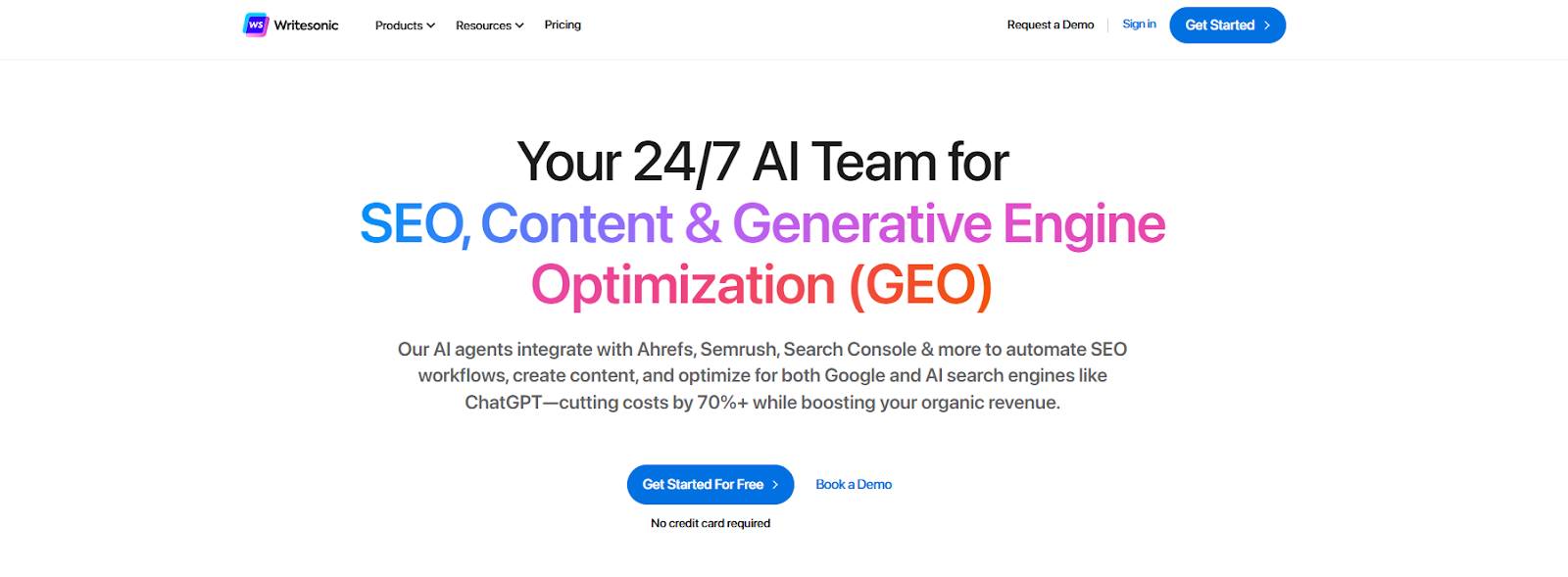
Writesonic is one of the fastest tools I’ve used for handling long-form content, especially when deadlines are tight and briefs are vague.
I’ve dropped in raw customer notes and watched it turn them into clean, structured blog drafts in minutes. It doesn’t just trim or reword, it rebuilds content with the end format in mind, whether that’s a listicle, a landing page block, or a short product blurb.
This AI summarizer handles long content well and supports 25+ languages, making it great for teams working across regions. I often use it to pull out the core takeaways from reports, then expand them back into multiple content formats depending on where it’s going.
What makes it stand out is its flexibility across tools. You can summarize a file, then use Chatsonic to ask follow-up questions, generate headlines, or even fact-check using its browsing feature. I’ve used that combo to go from dense PDFs to blog-ready outlines without switching tabs.
One thing to keep in mind is the credit system. If you’re generating longer or high-quality content, credits run out quickly. The free plan is quite limited, with just 25 credits and one article per month, which works only for testing things out.
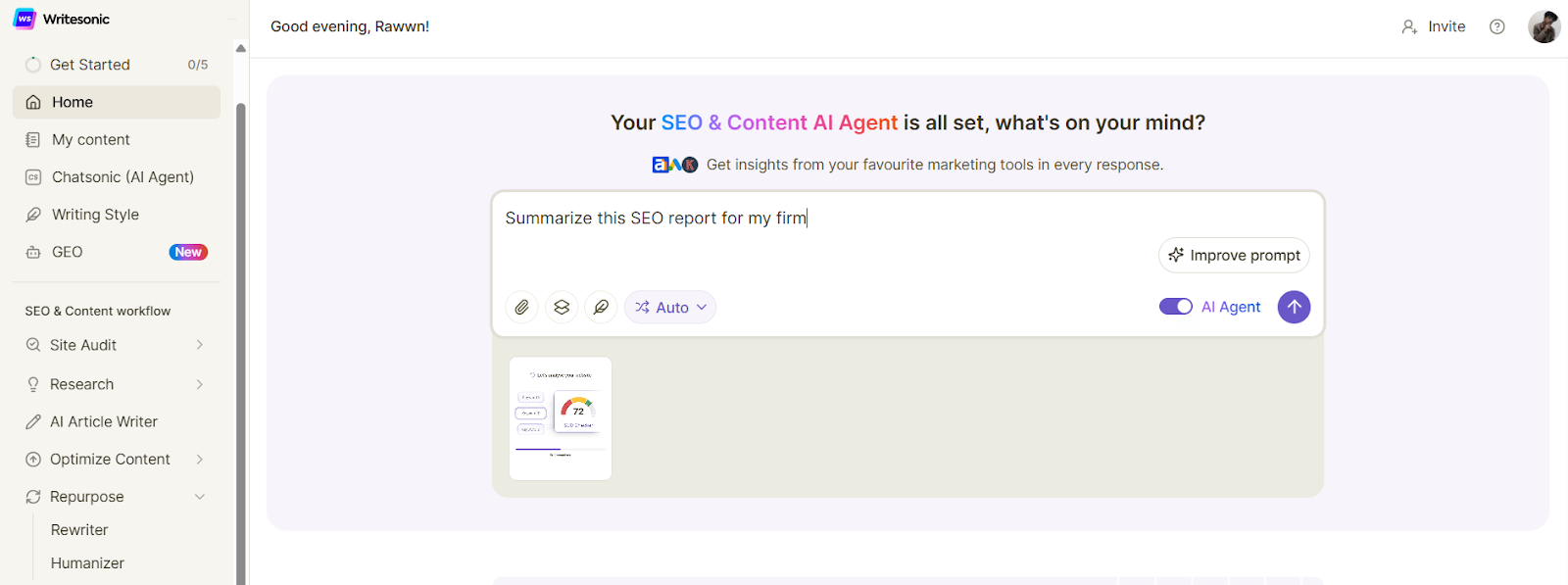
If you’re someone who works on a wide range of content formats and wants everything in one place, Writesonic offers solid value, especially for fast turnarounds and multi-language support.
Pros
- Offers tone and length settings for summaries
- Reliable for niche content (e.g., SaaS, DTC, legal)
- Allows cloning of writing styles for brand consistency
Cons
- Credit usage increases quickly with high-quality outputs
- Some features (like the plagiarism checker) are hard to access in the UI
Pricing
- Free Plan: Includes 25 credits, 1 article/month, and access to basic tools
- Basic Plan ($16/month): 1 user included, 1 project included, 10 AI agent generations/month, 5 articles/month, 1 Writing Style
- Lite Plan ($39//month): 1 user included, 100 AI agent generations/month, 15 articles/month, 2 Writing Styles
- Standard Plan ($79/month): 1 user included, Unlimited AI agent generations, 30 articles/month, 5 Writing Styles
- Professional Plan ($199/month): 2 users included, Unlimited writing styles, 100 articles/month
- Advanced Plan ($399/month): 5 users included, 200 articles/month, 4 projects included. Adds enterprise-grade security and compliance tools
{{cta}}
What Is the Best AI Summarizer in 2025?
Lindy is the best AI summarizer tool in 2025. It doesn't just work as a summarizer, but as a true assistant. Most tools stop at generating summaries. Lindy goes further by turning those summaries into action.
While other platforms require users to copy outputs into emails, task managers, or CRMs, Lindy handles that automatically. It joins meetings, creates clear summaries, extracts action items, and follows through, whether that means scheduling tasks, updating records, or sending messages. Everything stays connected without the need for manual input.
Lindy also integrates with tools like Zoom, Gmail, Notion, and HubSpot. It keeps context across conversations and platforms, making it especially useful for teams managing complex workflows. Smart defaults ensure nothing is sent or changed without approval, so users remain in control at every step.
For those who just need a quick summary, there are plenty of capable tools. But for professionals and teams who need follow-through, where summaries translate into real outcomes, Lindy is the only solution that bridges that gap.
How I Tested the Best AI Summarizers
This guide isn’t based on marketing claims or surface-level demos. Every tool on this list was tested in practical, real-world scenarios, the same way students, marketers, researchers, and remote teams use them day to day.
My goal was to find which tools deliver consistent, high-quality summaries across different formats and use cases. Here’s exactly what I evaluated:
- Real-world performance across content types: Each tool was tested beyond short snippets. I used them to summarize blog research, long-form articles, PDFs, meeting recordings, videos, and project threads. If a tool claimed to handle meetings, it was tested on actual call transcripts. If it targeted researchers, we fed it journal articles and academic papers.
- Accuracy and message preservation: Summaries had to do more than shorten content; they needed to preserve the core meaning, tone, and structure. I checked how well each tool adapted to different writing styles, from formal research to casual conversation. Strong performers delivered clear, relevant takeaways without losing nuance.
- Speed and usability: How quickly could I go from raw content to a usable summary? Tools were rated on responsiveness, simplicity, and whether the interface interrupted the workflow. Tools that worked fast and felt intuitive scored higher.
- Customization and control: I looked at how much control users had over the output. Could you adjust the tone or reading level? Choose between bullets or paragraphs? Highlight decisions only? The more options a tool offered, the more flexible and valuable it became, especially in professional settings.
- Exporting and integration: A great summary is only helpful if it fits into your workflow. Tools were tested for export options (PDF, TXT, DOCX), sharing capabilities (like link-based summaries), and integrations with platforms like Google Docs, Slack, and Notion.
- Value for money: I tested free plans to see if they were truly usable or just glorified trials. Paid plans were evaluated on whether their upgrades justified the cost. Tools with meaningful functionality in the free version were rated as more accessible and user-friendly.
This process helped me filter out tools that looked good on paper but fell short in practice. The tools that made it into this guide are the ones I’d return to for real work.
Lindy Makes Summaries Easy
Summarizing anything manually is a pain. Here’s why you should give Lindy a try:
- Say goodbye to manual labor: With Lindy, you can kiss those hand cramps goodbye. Lindy’s summary generator can take care of all your summarization needs, be it for YouTube, documents, Zoom meeting summaries, or even website summaries.
- Incredible accuracy: With accuracy levels exceeding 99%, you know Lindy will catch even the most difficult terms, even if the speaker’s got an accent thicker than the cast of Derry Girls.
- Customization is key: Adjust the length to your heart's content, and voila. Your perfect summary awaits. Can’t find what you need in the Marketplace? You can create your own Lindy in seconds and watch it go.
- A team at your fingertips: Need to do more than summarize documents and recordings? You can create an army of Lindies to tackle different tasks. The kicker? Lindies are collaborative, meaning you can pool their brain power together to maximize results.
Frequently Asked Questions (FAQs)
1. What is the best free AI summarizer?
Lindy is one of the best free AI summarizers out there. It even lets you manage your entire workflow and automate tasks. Scribbr is another reliable and accessible free option. You don’t need to create an account, there are no ads or distractions, and it generates summaries of up to 600 words.
2. Which summarizer is best for research papers or academic work?
Scholarcy is designed specifically for academic use. It breaks down papers into structured sections like methods, results, and conclusions. It also identifies key data, references, and limitations. If you're summarizing journal articles regularly, Scholarcy is built for that purpose.
3. Can I summarize PDFs, videos, or audio files?
Yes, but not every tool supports all formats. Notta and Lindy allow you to upload PDFs and even summarize live meetings or recordings. ChatGPT can summarize PDFs if you upload them (on the paid plan). Video and audio summarization typically require transcription first, which Notta does automatically.
4. Are these AI summaries accurate?
Yes, they’re quite accurate. Tools like Jasper, Writesonic, and Lindy produce summaries that are consistent and reliable. But if you’re using summaries for high-stakes content like legal documents or academic research, you should always read the original document to confirm the key points weren’t missed or misrepresented.
5. Which tools support multiple languages?
Writesonic, Quillbot, and Paraphraser support over 20 languages and allow you to summarize, paraphrase, or generate content in those languages. Tools like Scribbr and Scholarcy mainly support English only, whereas Lindy is an all-around multilingual tool.
6. Are any good summarizers completely free?
Yes. Scribbr and Paraphraser both offer free versions that let you summarize short content without signing up. They’re good for basic use, but more advanced features like saving documents or extracting action items are only available in paid tools like Lindy, which offer a free plan as well.
7. What’s the difference between summarizing and paraphrasing?
Summarizing involves condensing a larger text into a shorter form, focusing on the main points and ideas. Paraphrasing, on the other hand, rewrites a specific portion of text in your own words while maintaining the original meaning and level of detail.
8. Can AI extract action items from meetings or documents?
Yes, AI can extract action items from both meetings and documents. AI-powered tools can transcribe meetings, identify key points, and generate summaries, which often include extracting action items and assigning them to specific individuals. Additionally, AI can analyze documents like emails, reports, and notes to identify tasks and deliverables.
9. Which tool is best for team collaboration?
ClickUp is the best fit for teams already using project management software. It summarizes tasks, documents, and comments right inside your workspace. Lindy is also built for team use and offers multi-agent setups, CRM integrations, and human-in-the-loop workflows that are ideal for managing meetings and follow-ups.
10. Can I use these tools on mobile?
Yes. Most of the summarizers I tested, including Lindy, Notta, ClickUp, ChatGPT, and Paraphraser, work well on mobile browsers or apps. You can upload files, read summaries, and even trigger automation while on the move.



















.jpg)
.png)
.png)

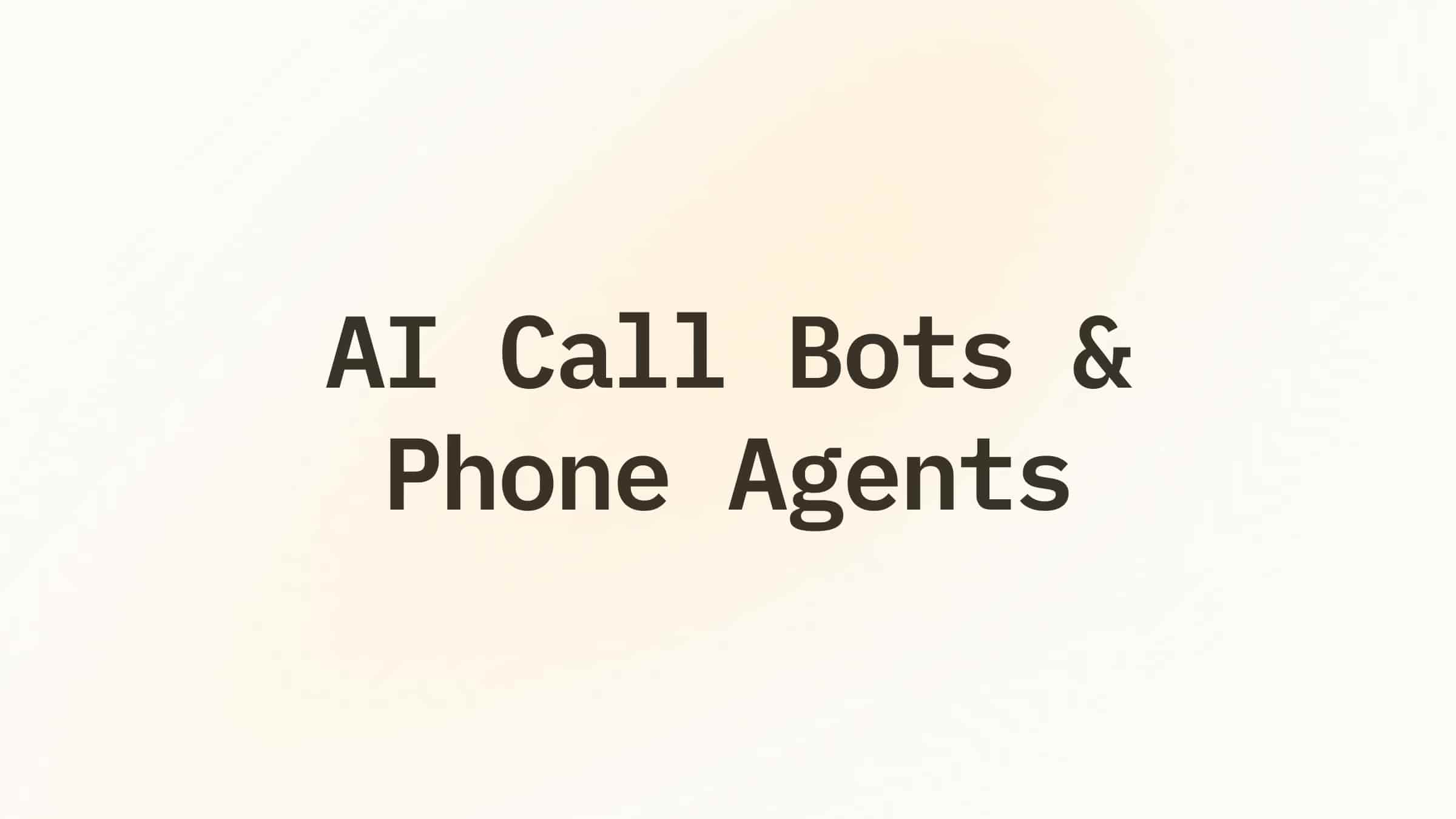
.png)
.png)